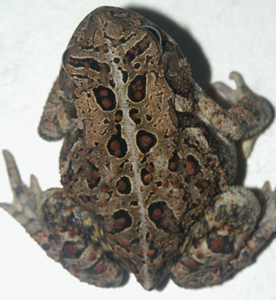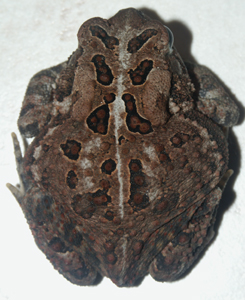

My Pet Toads of the Past and Present
Tobin Wetzel a.k.a. Mr. Tobes, November 3, 2019 - July 27, 2024
This poor guy got stuck out on a field trail at Wetzel State Park. There was no place to dig into the ground for at least 1/4 mile, if not 1/2 mile. It was November 3, 2019 and 43 degrees, predicted to be 28 that night. He was emaciated, cold, and barely moving. I put him in my bag and figured I'd keep him for the winter and let him go in the spring. Unfortunately, I later realized he also had lung damage (a crackle when he breathes, and inability to fully chirp), presumably from inhalation of herbicides sprayed on or near the field in which he was found. Fortunately, he has been so happy to be out of that predicament that he is the only toad I've ever had who never clawed at the glass to try to escape the terrarium. There was never a single footprint on the glass. He is named Tobin after the boy in the Stephen King movie, "In the Tall Grass", who was also lost in the grass.
January 14, 2022
Here he is in his dish. I never took any earlier photos of him because I didn't think he'd live very long, so these are the first ones.
February 18, 2022
Although he looks normal in his photos last month, he's been suffering from something strange with his hind legs. He hasn't been able to hop normally, and often has his legs either stretched out straight behind him, or upwards at a weird angle, like the photos below. He can't seem to control his hind legs. He sometimes flips over on his back after trying unsuccessfully to hop, and can't get turned over without my help. He also can't dig anymore and just stays at the surface of the soil.
October 5, 2022
I determined that the problem with Tobin's hind legs had to do with ingestion of neurotoxic pesticides contained within the crickets he was eating that were gut-loaded with carrots and spinach. I used to only gut-load the crickets with spinach, but in the summer/fall of 2021, I started feeding the crickets shavings from organic carrots. Vegetables can be grown using organic practices, yet still be contaminated by runoff from farms using pesticides, or rainwater containing volatilized pesticides. Apparently, the carrots were poisoned. I found this out because in May 2022, I caught a female mouse in a live trap in the garage and she had babies hours afterward, before I had a chance to release her. I planned to keep her and her babies safe until they were weaned, as I have done for other mice in this predicament. I had been feeding her peanuts and dog food, and decided to put in a carrot. The next day, she was dead. Fortunately, the baby mice were close to being weaned, and I was able to give them milk with droppers and introduce solid foods to them. They were all making great progress until I started feeding them a popular brand of organic steel cut oats. A couple days later, three of the five babies were dead, and one of the two living ones was having trouble using her hind legs. I discontinued the oats and went back to peanuts and dog food. She started recovering the use of her hind legs as she exercised on the wheel I had in their cage. She couldn't go as fast as her brother, but she did pretty well. Every five steps or so, one hind leg would kick out to the side, and never did normalize completely. The two living mice survived until December 31, 2022, after I introduced organic hazelnuts, which killed them by the following day. I was only trying to give them some variety---I thought the nuts would be good, since the peanuts didn't seem to cause any problem, but I was wrong, and they lost their lives. But fortunately, through these mice studies, I learned not to eat carrots or oats anymore. I also read that there was a study in which glyphosate levels were tested in different oatmeals, and even though this brand was organic, they still found glyphosate in 25% of the bags tested. It was just impossible to avoid, as long as this farm was also producing conventional oats sprayed with pesticides. I also learned that carrots especially absorb contaminants from the soil. One study found that carrots contained 80% of the concentrations of the chemicals in the soil. So carrots can be especially toxic if they are grown in contaminated soil, even if organic methods are used. I suspect the pesticides affecting hind leg use could be organophosphates, such as glyphosate, which is known to cause Parkinson's Disease in humans, and of course cancer.
After I stopped giving Tobin crickets gut-loaded with carrots, he regained normal use of his hind legs and can jump around fine! He can dig holes in the soil again! It is amazing that the condition turned out to be reversible. Here is Tobin enjoying a day outside.
October 27, 2023
Tobin is still doing well, considering his condition. He still has trouble breathing and chirping, but he can hop and catch food just fine. He enjoys relaxing in his water dish in real sunshine from the window or his UV bulb, and digging a hole in the dirt to settle down in. He still never claws at the glass to get out. I photographed him on a warm fall day in the moss area.
Right Hand Man, June 21, 2008 - May 11, 2012
This toad is #13 from my new toad studies. This is his first photo on the day of capture, June 21, 2008. He lost his left hand due to a yard accident I presume, which is why I decided to keep him.

The first two photos below are of a huge 71-gram, 3 1/8" toad that my parents found in their yard. I photographed and as much as I really wanted to keep her, I decided to release her back where she was found. She is pictured with Right Hand Man for the remainder of the photo shoot taken on October 4, 2011.
Here is Right Hand Man on his back---you can see his strange "foot" that regenerated from the stump.
Here is Right Hand Man hanging out with Don the Spadefoot.
On May 11, 2012, Right Hand Man succumbed to an illness. This was the second year he had trouble in the early spring after living through the winter without hibernating. He lost his appetite in the spring of 2011 and had to be force-fed for several weeks until he ate again on his own. The same thing happened in the spring of 2012, but this time, he also had a respiratory infection that caused a lot of mucus buildup. He had trouble breathing. After 8 difficult weeks of force-feeding and seeing only a worsening of his condition, I made the decision to allow him to die (when rehabilitation becomes torture, sometimes that is all one can do, and I could tell he was in pain---I couldn't even touch him without seeing him cringe. It was so sad.). He died 4 days after I stopped force-feeding. I have decided that I will not be keeping any more wild toads as pets. If any more are injured, I will make sure their wounds heal, then they will be released back into the yard, even if they are missing a hand or foot.
Triangle Toad, June 5, 2008 - November 8, 2010
Triangle Toad was a toad I kept from my toad studies at my old house. She was Toad 102 and was first found on June 5, 2008. She lived with Don the Spadefoot and Right Hand Man. She seemed to have a lot of respiratory infections when I found her in the wild many times at the old house, so I decided to take her to the new house in the summer of 2009 and keep her as a pet. She lived very happily for a while, but then later succumbed to some kind of skin disease at the same time I lost two other wild, captive toads.
Here is her first photo on June 5, 2008. The reason she is named Triangle Toad is the triangle shape near her left upper back.

On August 28, 2009, Right Hand Man had Triangle Toad in an amplexus grip today, something I've never seen any wild toads do in captivity.
Here is Don on May 21, 2010, snuggled up with Triangle Toad, Also pictured is Right Hand Man, from my new toad studies.
Here is Don on September 3, 2010. Behind him is Triangle Toad and an unnamed toad on top of her head.
[ Lyle Sundog Gordon ] [ Darwin, the Amazing Border Collie ] [ Dogs of the Past ]
[ Don the Spadefoot ] [ Frank the Spadefoot ] [ Other Spadefoots ]
[ Twista the Dancing Clawed Frog ] [ African Clawed Frog Development ]
[ Pet Toads ] [ Wild Detroit Toads ] [ Wild Metro-Detroit Toads ]
[ Bunny Boy ] [ Beatrice the Mallard Duck ] [ Caring for Abandoned Sparrow ]
[ Past Fish and Other Pets of the Past ] [ Pepper Loach ] [ Box Tortoises ]
[ Biglegs the Jumping Spider ] [ Tufts and Mr. Greenfangs ] [ Radinka the Platycryptus undatus ] [ Caring for Jumping Spiders ]
[ Home ] [ Artwork ] [ Photography ] [ Art Cars ] [ Virtual Museum ] [ Pets ] [ Favorite Links ] [ What's New / My Blog ] [ Guestbook ] [ For Sale ]
Copyright © 2004-2024 kozmicdreams.com. All rights reserved.
All materials contained on this site, including text, graphics and icons, are the property of
kozmicdreams.com.